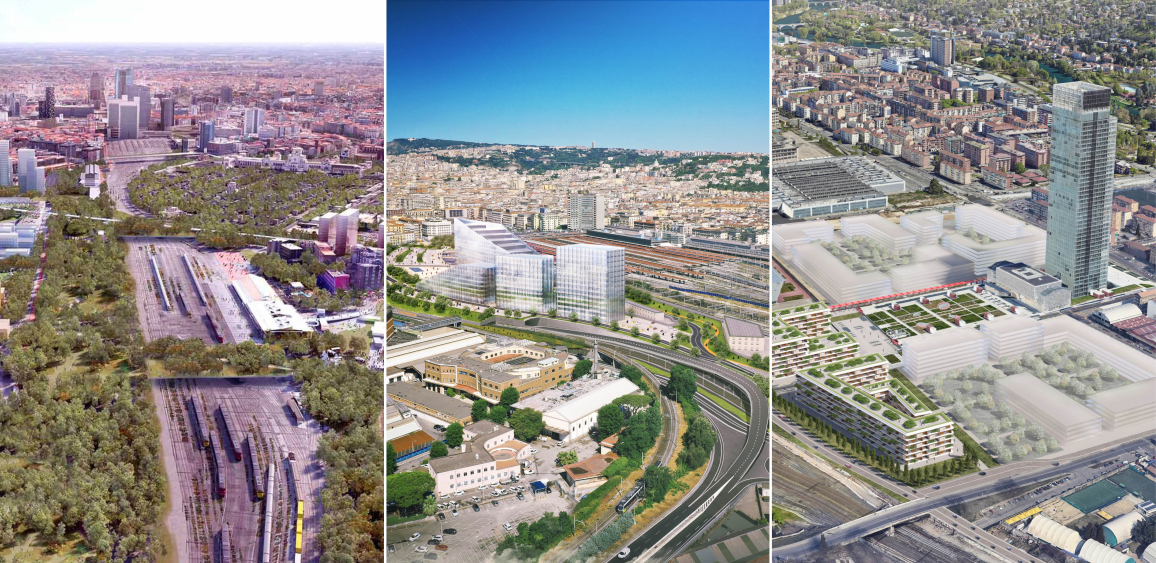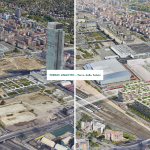Surrounded by greenery, capable of creating moments of aggregation and culture, increasingly safe and usable: these are the railway yards of the future according to FS Sistemi Urbani, lead company of the FS Group’s Urban Pole. Ideas turned into ongoing projects in five Italian cities: the Milan, Rome and Naples rail yards, as well as those for the redevelopment of the Bologna Ravone – Prati site and for the Ponente Ligure bike path.
PROJECTS IN DETAIL
“Sustainable urban regeneration”
The urban regeneration project for Milan’s seven stopovers will transform the face of the city, making it greener, more social and open to innovation. In fact, greenery is a central element of the project and its usefulness manifests itself not only as a space for sociality and well-being but also as a climatic device capable of purifying the air and regulating temperatures, thus promoting energy savings. In fact, the Program Agreement signed in 2017 by the FS Group, the Lombardy Region and the Municipality of Milan, stipulates that most of the square meters affected by the transformation will be allocated to green space, with a minimum percentage of more than 65 percent. Social, because places of aggregation and culture will be central to the various development projects, and public consultation with those who live the city on a daily basis is a fundamental element of the regeneration path for each airport, thus broadening the decision-making process. But the city will also be more open to the future and innovation thanks to the creation of places such as student halls, coworking spaces and cultural hubs that will encourage the meeting and exchange of ideas and know-how. Milan will be an increasingly human-friendly city: in fact, the various master plans include different solutions to encourage soft and shared mobility and to stitch together urban areas that until now have not had the opportunity to dialogue with each other.
“Urban Regeneration in Rome Node Areas.”
Roma Termini station is preparing for Jubilee 2025 with the redevelopment of Piazza dei Cinquecento and adjacent streets. The ongoing construction sites are preparatory to the radical transformation of the area and will improve its usability, with positive implications in terms of functionality, urban decorum and safety. The first part of the project will be completed in December 2024 to allow the Jubilee to take place, while completion is scheduled for 2026.
The urban area around the Roma Tiburtina High-Speed Station is also the subject of the Urban Development Plan for the urban and functional redevelopment of the entire area, approved in 2000. To date, important infrastructural interventions have been carried out (HS station, road system, public spaces) and the first building subdivisions have been implemented (BNL, Sapienza, receptive lot). With the proposed urban variant, currently being discussed with Roma Capitale, urban regeneration will continue on the eastern side – in synergy with the new developments of the Pietralata area affected by the AS Roma new stadium project – where a new modern neighborhood with a flexible and varied functional mix, with buildings distributed along the railway axis, a public park and urban connections to the Nomentano district are expected to be established.
With a view to transforming the Roma Trastevere railway station as a transportation hub and a center of attraction for travel-related and nontravel-related services, a Memorandum of Understanding was signed in October 2023 to define the objectives and functions to be implemented in the area. The agreement calls for the opening of a second entrance on the south front of the station through the reopening and extension of an existing station underpass to connect to Via Portuense. This intervention, financed by Rete Ferroviaria Italiana with 10.5 million euros, will allow an increase in the station’s pedestrian basin by almost 50 percent and will enable the redevelopment of the area, the rationalization of green spaces and traveler services with the creation of internal roadways and Kiss&Ride points. The south front will be accessible by the end of 2025.
“FS Sistemi Urbani and the C40 Reinventing Cities competition – Focus Bologna.”
Sustainability is at the heart of all the urban regeneration projects carried out by our company, which has taken part in all three editions of the international competition Reinventing Cities, called by the C40 Cities network to promote resilient and sustainable urban development. Five teams, five project ideas to environmentally and urban redevelop the Bologna Ravone-Prati site, owned by the FS Group. The five finalist teams of the third edition of the international Reinventing Cities competition, a call launched by C40 Cities, a network of more than 80 major cities around the world committed to working together to combat climate change and its effects, have been selected. The Reinventing Cities competition promotes zero-impact urban developments by presenting the best proposals for transforming underutilized sites as examples of sustainability. So far, Bologna, Bristol, Cape Town, Chicago, Houston, Izmir, Lyon, Madrid, Milan, Montréal, Naples, Oslo, Paris, Phoenix, Reykjavík, Rome, San Francisco, and São Paulo have participated in the initiative.
“The Ponente Ligure Bicycle and Pedestrian Trail.”
One of Italy’s most important bicycle and pedestrian paths comes to life in Liguria. For those who like to get around by bike, there will be 20 kilometers of track, in addition to the 24 already built up to San Lorenzo al Mare, dedicated to the citizens and frequenters of the Ponente Ligure area. ON OCTOBER 16, 2023, a preliminary sale agreement was signed between FS Sistemi Urbani CEO Umberto Lebruto and the mayor of Imperia, Claudio Scajola, for the sale of disused areas no longer functional for railway activities and five former warehouses owned by Rete Ferroviaria Italiana, as well as a former railway tollgate owned by the FS Group. The sale allows, through Bandi Periferie funding, the completion of a bicycle and pedestrian path affecting four other municipalities in western Liguria: Diano Marina, San Bartolomeo al Mare, Cervo and Andora. It involves a total of about 138,500 sq. m. of land and real estate, including about 1,066 related to the five former warehouses, four of which are located in the Oneglia area and in Porto Maurizio, and about 270 sq. m. related to the former railroad tollgate. The transfer allows, through Bandi Periferie funding, the completion of a bicycle and pedestrian path affecting four other municipalities in western Liguria: Diano Marina, San Bartolomeo al Mare, Cervo and Andora.
“Naples – the urban regeneration of railway areas as gateways to the City.”
Redevelop the area of the former Naples Porta Est freight yard and create a multimodal hub by uniting the train with all other means of transportation: metro, buses, ships and planes. In Naples, FS Italiane’s Urban Hub companies are working in synergy with various local authorities to develop urban regeneration and sustainable mobility projects that will ensure renewed usability of spaces for the benefit of citizens with development of new public and private functions. Work will be started on the urban planning variant that will allow the transformation of the East Naples railway yard areas into a hub. Thanks to the stitching interventions, the two parts of the city, the business center and East Naples, will be brought into close connection and complementarity. The works aim at economic, social and especially environmental sustainability interventions with the creation of a large linear park called “Green Km.”
The area is at the center of all other mobility systems, first of all with the Napoli Centrale station and its High Speed, Intercity and Regional trains, then with the Naples Metro lines 1 and 2, which will allow easy connection with Capodichino Airport and the port of Naples, and finally with the road system. In addition to the “green kilometer,” interchange parking lots will be built for buses and private vehicles.
Italiano






